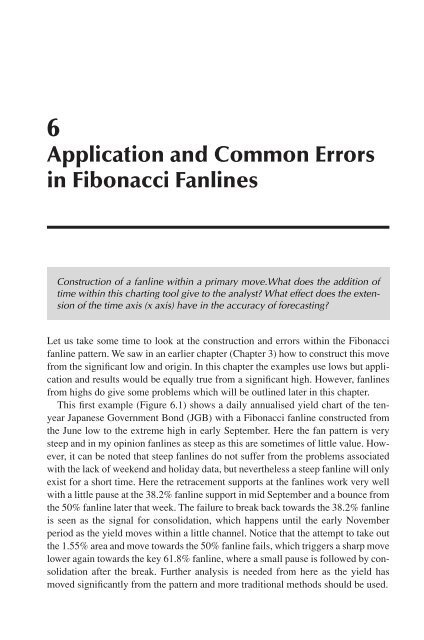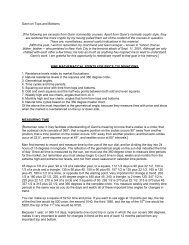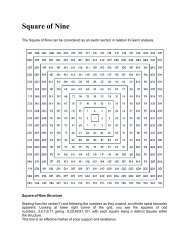Fibonacci and Gann Applications in Financial Markets
Fibonacci and Gann Applications in Financial Markets
Fibonacci and Gann Applications in Financial Markets
Create successful ePaper yourself
Turn your PDF publications into a flip-book with our unique Google optimized e-Paper software.
6<br />
Application <strong>and</strong> Common Errors<br />
<strong>in</strong> <strong>Fibonacci</strong> Fanl<strong>in</strong>es<br />
Construction of a fanl<strong>in</strong>e with<strong>in</strong> a primary move.What does the addition of<br />
time with<strong>in</strong> this chart<strong>in</strong>g tool give to the analyst? What effect does the extension<br />
of the time axis (x axis) have <strong>in</strong> the accuracy of forecast<strong>in</strong>g?<br />
Let us take some time to look at the construction <strong>and</strong> errors with<strong>in</strong> the <strong>Fibonacci</strong><br />
fanl<strong>in</strong>e pattern. We saw <strong>in</strong> an earlier chapter (Chapter 3) how to construct this move<br />
from the significant low <strong>and</strong> orig<strong>in</strong>. In this chapter the examples use lows but application<br />
<strong>and</strong> results would be equally true from a significant high. However, fanl<strong>in</strong>es<br />
from highs do give some problems which will be outl<strong>in</strong>ed later <strong>in</strong> this chapter.<br />
This first example (Figure 6.1) shows a daily annualised yield chart of the tenyear<br />
Japanese Government Bond (JGB) with a <strong>Fibonacci</strong> fanl<strong>in</strong>e constructed from<br />
the June low to the extreme high <strong>in</strong> early September. Here the fan pattern is very<br />
steep <strong>and</strong> <strong>in</strong> my op<strong>in</strong>ion fanl<strong>in</strong>es as steep as this are sometimes of little value. However,<br />
it can be noted that steep fanl<strong>in</strong>es do not suffer from the problems associated<br />
with the lack of weekend <strong>and</strong> holiday data, but nevertheless a steep fanl<strong>in</strong>e will only<br />
exist for a short time. Here the retracement supports at the fanl<strong>in</strong>es work very well<br />
with a little pause at the 38.2% fanl<strong>in</strong>e support <strong>in</strong> mid September <strong>and</strong> a bounce from<br />
the 50% fanl<strong>in</strong>e later that week. The failure to break back towards the 38.2% fanl<strong>in</strong>e<br />
is seen as the signal for consolidation, which happens until the early November<br />
period as the yield moves with<strong>in</strong> a little channel. Notice that the attempt to take out<br />
the 1.55% area <strong>and</strong> move towards the 50% fanl<strong>in</strong>e fails, which triggers a sharp move<br />
lower aga<strong>in</strong> towards the key 61.8% fanl<strong>in</strong>e, where a small pause is followed by consolidation<br />
after the break. Further analysis is needed from here as the yield has<br />
moved significantly from the pattern <strong>and</strong> more traditional methods should be used.






